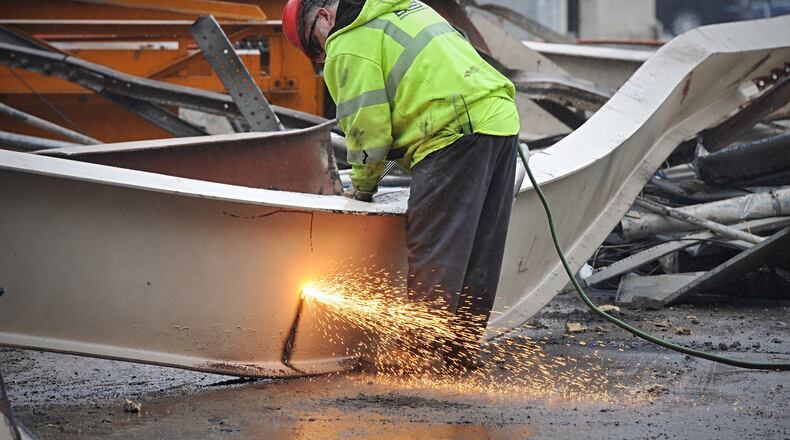This economic crisis is unlike any before it in the speed and severity of the jobs destruction, and certain industries, like leisure and hospitality, were absolutely creamed by the COVID-19 lockdown.
“These losses are terrible for our community, but also for our state and country,” said Jeff Hoagland, president and CEO of the Dayton Development Coalition. “For businesses and their employees, these numbers represent significant hardship.”
The local economy is gradually reopening, and some laid-off and furloughed workers are being rehired.
But the big question is how long it will take for payrolls to return to pre-coronavirus levels.
Coronavirus: Complete Coverage by the Dayton Daily News
Employment in the Dayton metro area fell to 345,100 last month, from 389,100 in March. The metro area includes Montgomery, Miami and Greene counties.
Until last month, the most jobs the Dayton metro area had lost in any one month was 8,200 in mid-1998, according to Bureau of Labor Statistics’ records dating back to 1990.
April’s job losses were far worse than any year in the last three decades, even during the depths of the Great Recession. The most net jobs the Dayton region lost in any one year was 16,900 in 2009.
But the state’s stay-at-home order and efforts to slow the spread of the coronavirus resulted in widespread business closures, layoffs and wage and hour reductions.
The hardest-hit industry was leisure and hospitality, where local employment decreased by 12,600 jobs, or nearly 33%, according to not seasonally adjusted data.
MORE: Gen Z workers in southwest Ohio crushed by coronavirus downturn
Bars closed and restaurants shut down entirely or only continued providing carryout and drive-through services. Indoor dining only reopened last week, with restrictions.
Many Dayton-area bars and restaurants have reopened or plan to soon. But with reduced seating capacity, it’s unclear if and how long it will take for businesses to rehire laid off workers.
“Hospitality and retail have been decimated because of Covid-19,” said Chris Kershner, executive vice president of the Dayton Area Chamber of Commerce. “It’s not just impacting the employers, it’s also hurting the employees.”
The Ohio Restaurant Association estimated that about half of Ohio’s 23,000 establishments were closed for more than eight weeks and sales were down between 20% and 90% at those that were open for carryout, drive-through and delivery.
On Wednesday, the association said more than 80% of restaurants in the state are now open, and owners and operators are starting to rehire some of the 300,000 Ohioans who were laid off or furloughed because of the pandemic.
The leisure and hospitality industry also includes hotels and lodging businesses, which saw demand disappear suddenly.
By April, most hotel rooms went unfilled and huge numbers of hotel workers were put out of work.
Nationally, the hospitality and leisure industry lost 7.7 million jobs last month — nearly as many jobs as the next four sectors combined, according to the American Hotel & Lodging Association.
“The hospitality industry is in a fight for survival,” said Chip Rogers, the association’s president and CEO.
In the Dayton region, retail trade employers slashed 5,400 jobs last month, or 14.3% of their workers.
General merchandise stores, in particular, reduced staff by about 24%.
Education and health services saw payrolls decline more than 9%, or 7,200 jobs.
MORE: Alone during coronavirus: Dayton ranks 3rd in U.S. for living solo
Goods-producing companies got rid of 5,300 workers (9.4% of its labor force), while manufacturing companies cut 3,900 workers (nearly 9% of employees).
As bad and unprecedented as the job losses were, the Dayton metro area fared better than other urban areas: Dayton had the smallest one-month decrease in payrolls out of the state’s 11 metro areas.
Toledo saw the largest employment reduction of nearly 18%.
Before this crisis, the local economy saw strong growth, and it has become more diverse than it was 10-25 years ago, which helps protect against downturns, said Hoagland, with the Dayton Development Coalition.
The local economy used to be more heavily concentrated in manufacturing, but Hoagland said more recently it has added jobs in tech, health care, logistics and distribution and at Wright-Patterson Air Force Base.
This downturn is very different than past recessions, which makes it hard to predict what the recovery will look like or when a rebound might begin, Hoagland said.
But it’s very important to retain existing jobs, and the coalition and other partners are helping local companies maintain operations and attract jobs to the region, he said.
“The one thing I know for sure right now is that Dayton is ready for this challenge,” Hoagland said. “The last year has been incredibly difficult for our community, but we are still fighting. … We came together to take care of one another when it mattered most, and we’re doing the same thing now.”
The world is experiencing the same economic struggles as the Dayton area, and when the global economy rebounds, the region’s will too, said Kershner, with the chamber.
The local economy was strong before COVID-19, and it will return to strong economic growth again, he said.
“Fortunately, we were well diversified and our economy was going strong when we entered Covid-19,” he said. “We will emerge even stronger.”
Kershner said the community needs to support local businesses now more than ever.
“Businesses in the Dayton area are owned by our neighbors, our family and our friends,” he said. “We need to take care of each other and support local business owners.”
About the Author

